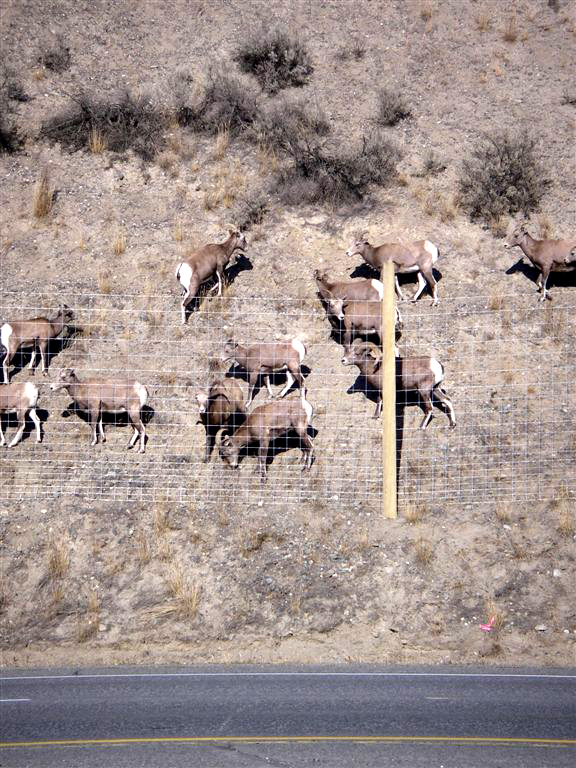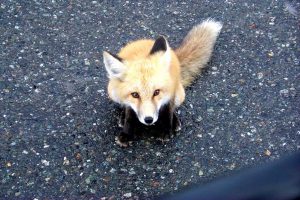
Roadkill is never pretty – but tracking the grisly results of wildlife-vehicle collisions is the basis of reducing such future accidents.
This is the rationale behind the Wildlife Accident Reporting System, (WARS) which has been maintained by the Ministry of Transportation and Infrastructure, since 1978. It’s hard to talk about the ministry’s wildlife accident mitigation efforts on B.C.’s highways, without referring to the system which contains more than 109,000 records collected over 35 years.
Information in the system is provided mostly by our road maintenance contractors, who clean up after wildlife collisions. These people identify and record the species and location of the animal, and the estimated time of its death – dawn, day, dusk or dark. They are assisted by the ministry’s Wildlife Roadkill Identification Pocket Guide which has photos and detailed descriptions of species ranging from badgers to bison.
What to do after a wildlife collision or when you encounter roadkill:
- Call the RCMP if there are human injuries, vehicle damage, or the animal carcass presents a highway safety issues
- Report vehicle damage to your insurance company
- Call the Conservation Officer Service if there is an injured animal to report at 1.877.952.7277
- Contact the Highway Maintenance Contractor who is responsible for removing carcasses on provincial highway
- Find contact information by service area on gov.bc.ca
- Alternatively, visit the DriveBC Website, click on “Report a Highway Problem” and then “Highway, Maintenance, and Bridge Problems”
Roadkill identification guide helps with recording wildlife accidents.
Recording animal highway fatalities is important because the cost of wildlife collisions goes beyond the loss of our fellow creatures. Between 1988 and 2007, 37 people were killed in wildlife-related motor vehicle collisions. The Insurance Corporation of British Columbia reports that wildlife is the second highest environmental factor requiring police attendance at accidents, next to weather. In 2010, the corporation spent more than $23 million on wildlife-related motor vehicle accident claims.
The information gathered in the Wildlife Accident Reporting System helps us to:
- Identify accident-prone locations
- Conduct mitigation efforts – eg. wildlife overpasses, fencing, tunnels, warning signs
- Evaluate mitigation techniques
- Assist with highway planning
- Analyze traffic and climatic relationships for specific species
- Develop accident risk profiles for stretches of highway
- Establish policies and strategies for accident mitigation
Not only does the system guide a great deal of our work to keep motorists and wildlife safe, but its long-established, multi-species, geographically oriented database is popular with researchers, consultants, media, industry, wildlife associations, special interest groups, and other government agencies. These folks account for 70 per cent of the specialized reports we produce, beyond our regular annual and multi-decade reports. For example, the B.C. Ministry of Environment draws on the system to assess wildlife population trends, while industry uses it to guide development of their roads. That’s because the system offers information unavailable elsewhere.
In B.C., there are 133 native and nine introduced species of animal, which may travel over almost 94,000 kilometres of highway lane. That’s a lot of potential interaction between animals, roads and vehicles. But tracking these always unattractive carcasses helps us to reduce future fatal encounters (and injuries) when animals meet motorists on highways.

TranBC Trivia
According to Wikipedia, our Wildlife Roadkill Identification Pocket Guide (first released in 2008) was the first wildlife roadkill identification guide produced by a government agency in North America. Deer account for about 76 per cent of all wildlife fatalities reported annually, in B.C.
I am trying to connect as we hit – injured 2 deer. One may make it but both alive not bleeding but legs will not support them. If going south on HWY towards Spence bridge from Ashcroft there is a place to stop and use washrooms on left. 6km from there south on either side of Hwy nestled in scrubs are the deer. Seems like just before epsom provincial park. I have pin in my map. Close to a marker
Hello Dana – thanks for letting us know. We ask that you also share this information with our maintenance contractor in the area, as they assist us in tracking this information (and collecting deceased animals on the roadway as required).
Service Area 15 – Thompson (Kamloops)
Argo Road Maintenance (Thompson) Inc
Phone: 1-800-661-2025
Website: argoroads.ca/service-areas/thompson
Twitter: @Argo_Thompson
Facebook: @ArgoRoadsThompson
Instagram: @argoroads
Email: argokam@argoroads.ca
Dead deer on highway before exit 151 westbound side
Hello Carol – thank you so much for connecting with us here about this. If you even notice this, the best course of direct action is to share your observation with our maintenance contractor for the area, using our report a highway problem. Here’s a link for future reference: https://drivebc.ca/rahp/identifyRegion.html
So how do people reloetwidlufe killed on the road?I called the RCMP and they scoffed at me and literally said they would not so anything. I witnessed family of racoons with 3 babies hit and killed in a horrible way
Hi me,
We are saddened to hear of this incident. We encourage you to reach out to our local area office to determine if you can do anything further (we’re including the link below). You might also want to reach out to your local wildlife rescue as well. Thanks for connecting with us here.
https://www2.gov.bc.ca/gov/content/transportation/transportation-reports-and-reference/regional-district-contacts